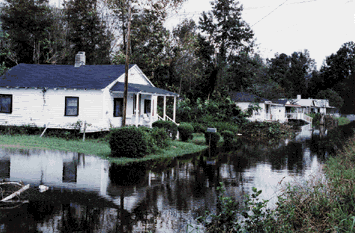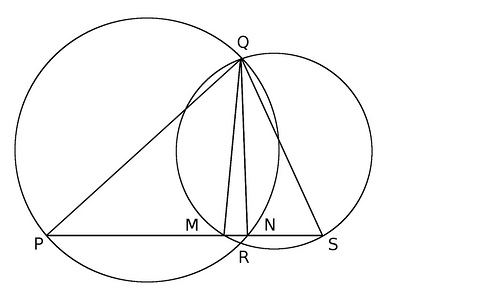Where do SWINGER and PYGMIES have the same meaning?
On a telephone keypad.
Where do SWINGER and PYGMIES have the same meaning?
On a telephone keypad.

You and I are walking through a dark alley. You are explaining that it’s wrong to kill an innocent person, but that it’s morally permissible to kill someone who is threatening your life.
At that moment an attacker leaps out of the shadows — and you find that, because of my position, you cannot defend yourself without also killing me.
In that instant, what is your moral obligation? You must not kill an innocent man. But my presence is threatening your life, so in that sense I am not innocent and can be sacrificed.
But if there’s no imperative to spare my life, then I’m no longer a hindrance to your self-defense … in which case I’m innocent again and you’re not justified in killing me.
And so on.
The following account of unusual phenomena was received March 10, at the Hydrographic office, Washington, from the branch office in San Francisco. The bark Innerwich, Capt. Waters, has just arrived at Victoria from Yokohama. At midnight of Feb. 24, in latitude 37° north, longitude 17° 15′ east, the captain was aroused by the mate, and went on deck to find the sky changing to a fiery red. All at once a large mass of fire appeared over the vessel, completely blinding the spectators; and, as it fell into the sea some fifty yards to leeward, it caused a hissing sound, which was heard above the blast, and made the vessel quiver from stem to stern. Hardly had this disappeared, when a lowering mass of white foam was seen rapidly approaching the vessel. The noise from the advancing volume of water is described as deafening. The bark was struck flat aback; but, before there was time to touch a brace, the sails had filled again, and the roaring white sea had passed ahead.
— Science, March 20, 1885
A narrow escape from destruction by an immense meteor was reported this morning by officers of the steamer Cambrian, which arrived from London. The huge fiery mass struck the water within fifty yards of the Cambrian’s starboard bow last Friday evening when the ship’s position was longitude 51.10 west, latitude 42.05 north, several hundred miles south of Cape Race.
[Third officer Daniel Vittery:] ‘The air was filled with a deafening din such as a thousand railroad trains in a tunnel might create. The hiss of dropping fragments gave me the fleeting impression of the ship’s boilers leaking in every plate. … With a crash that shook the ship the monster struck the sea not fifty yards away, and the upheaval was terrific. Not a rope nor a spar was scathed when the meteor, big as a fair-sized house, went squarely over us and struck the sea.’
— The Friend, Sept. 21, 1907
My infant son rules his mother.
His mother rules me.
I rule the Athenians.
The Athenians rule the Greeks.
The Greeks rule Europe.
And Europe rules the world.
Thus my infant son rules the world.

The gold medal for canine endurance goes to Petey, the junkyard dog who guarded Al’s Auto Salvage in New Bern, N.C., in 1996. Petey was only 10 inches tall, and when Hurricane Fran roared up the North Carolina coast on Sept. 5, he was locked in a building that flooded with 16 inches of water.
Owner Skip Crayton feared the worst, but when he opened the shop the following morning, out came Petey, covered up to his neck in oil and mud. Apparently the dog had swum continuously for six to eight hours in the flooded building, keeping his head just above water to stay alive.
Petey couldn’t tell of the experience, of course, but when Crayton got him home he slept for two days.
See also The Dog of Pompeii.
novercal
adj. like a stepmother
materteral
adj. suggestive of an aunt
In 1984, philosopher William Lycan published a paper with this statement:
The probability of the title of this paper, given itself (and the fact of its being a generalization), is less than 1/2. Yet the probability of any contingent statement given itself is 1. So 1 is less than 1/2.
The title of the paper was “Most Generalizations Are False.”
In other words, the chance that any statement is true, given itself, is 1. But the chance that Lycan’s title is true, given itself, is less than 1/2. Thus 1 is less than 1/2.

Consider any two circles intersecting at points Q and R. Their diameters are QP and QS. PS intersects the circles at M and N.
Now, any angle inscribed in a semicircle is a right angle. This means that both QNP and QMS are right angles — and thus that there are two perpendiculars from Q to PS. Doesn’t it?
What is it with poets and doppelgängers? From a letter from Lord Byron to John Murray, Oct. 6, 1820:
In the latter end of 1811, I met one evening at Alfred my old school and form-fellow, … Peel, the Irish secretary. He told me, that, in 1810, he met me, as he thought, in St. James’-street, but we passed without speaking. He mentioned this, and it was denied as impossible; I being then in Turkey. A day or two afterwards, he pointed out to his brother a person on the opposite side of the way: ‘There,’ said he ‘is the man whom I took for Byron.’ His brother instantly answered, ‘Why it is Byron, and no one else.’ But this is not all:– I was seen by somebody to write down my name among the inquirers after the king’s health, then attacked by insanity. Now, at this very period, as nearly as I could make out, I was ill of a strong fever at Patras, caught in the marshes near Olympia, from the malaria. If I had died there, this would have been a new ghost story for you.
Similar experiences befell Shelley, Goethe, John Donne, and Wilfred Owen.
Shouldn’t ENCOURAGE rhyme with ENTOURAGE?